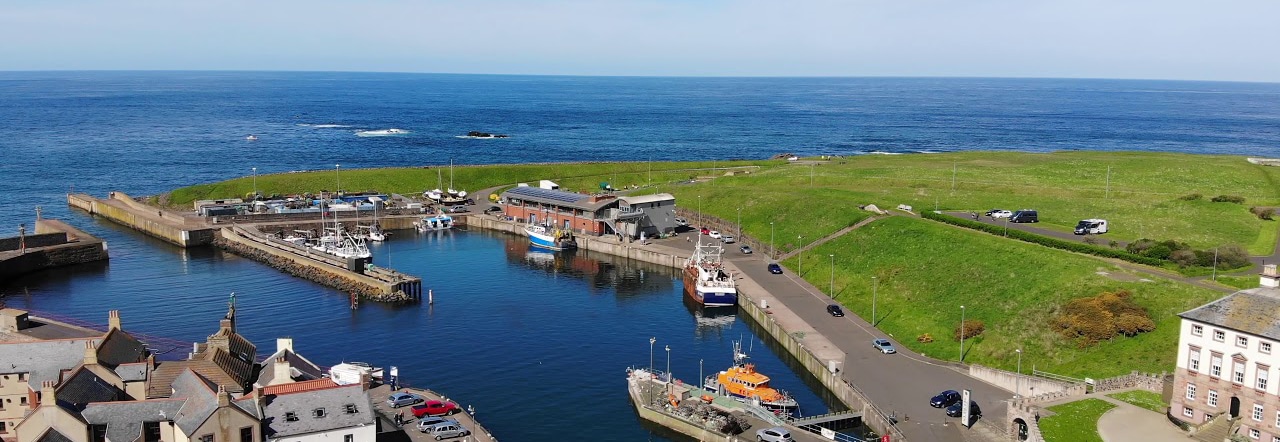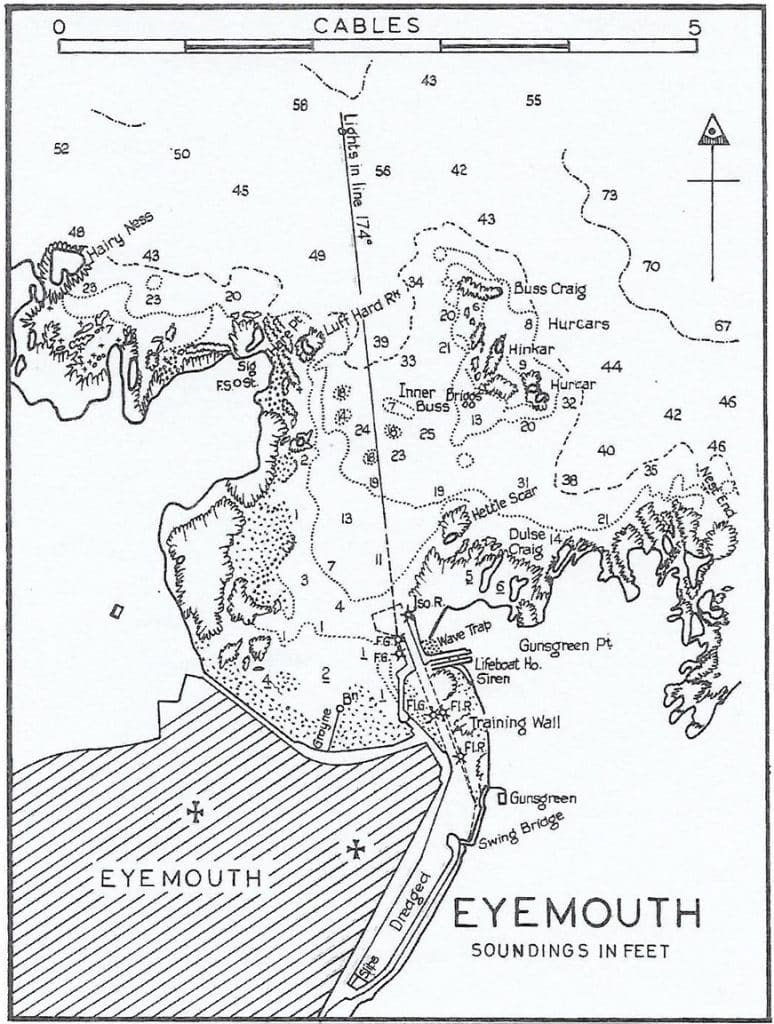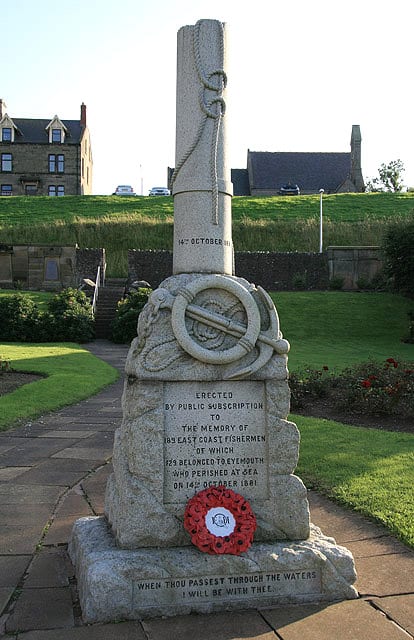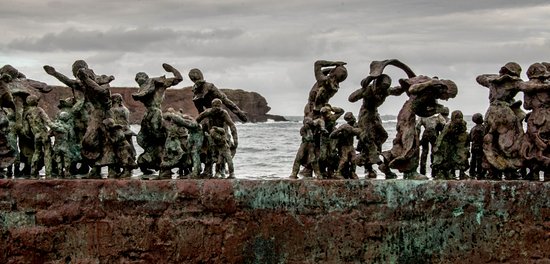

By Sue Fallon and Lynne Vosper
The town of Eyemouth in Berwickshire on the East Coast of Scotland was a busy fishing port with a large fishing fleet landing huge catches of haddock and herring. In October 1881 the fishing fleet suffered a devastating disaster which was named by the residents of the town as ‘Black Friday’.
The weather on the east coast of Scotland is well known for its wet and windy storms, lying as it does in the path of eastward moving Atlantic depressions which bring rain and cloud throughout the year and windstorms in the autumn and winter. During the 19th century there were several fishing disasters, notably the Stotfield disaster of 25 December 1806 when a storm struck the Moray Firth and the village of Stotfield lost its three fishing boats and all its able-bodied men and youths, 21 in total, in one afternoon. The Moray Firth disaster of 19 August 1848 was caused by a violent storm in which 124 boats and 100 fishermen were lost, leaving 47 widows and 161 children.
As a result of the Moray Firth disaster the government commissioned a report from Captain John Washington of the Admiralty to investigate the tragedy and to make recommendations for safety improvements in the fishing industry. His conclusions were firstly that the open-hulled design of the boats could lead to swamping in heavy seas, and secondly that there was a shortage of good quality harbours accessible to fishing vessels in all tidal conditions.
The report led to the encouragement of the introduction of decked vessels. However, the fishermen initially resisted the introduction of decks as it reduced the space available for the catch, and they also feared that a deck would increase the risk of men being swept overboard. The report also led to the improvement of many of the small harbours around the east coast of Scotland. However, the harbour at Eyemouth was one of the few not to be improved after the Moray Firth disaster. In 1841 the people of the town had rebelled against a fishing tithe imposed on them by the Church of Scotland and so the town was not viewed with favour by the authorities.

Chart of Eyemouth Harbour (based on British Admiralty Charts with the permission of the Controller of HM Stationery Office and the Hydrographer of the Navy, taken from Charts No. 114A.137). From Cruising Association Handbook.
Storms battered the east coast throughout the spring and summer of 1881 and the fishermen of Eyemouth were hard-pressed to land any fish. The bad weather continued in the first part of October which kept the fleet ashore and many of the families were hungry but when it appeared calm on Friday 14 October 1881, the fishermen decided to risk going to sea although the barometer on the pier head remained low. In Eyemouth it was the tradition that if one boat sailed the whole fleet were honour bound to sail too. After the fleet had left, the post office received a telegram from Yarmouth, where 56 of the Eyemouth fleet had gone to fish for late herring, warning of gales to come, but it was too late to warn the fleet.
The boats sailed for just over three hours and arrived, eight to nine miles from land, at the fishing grounds and shot their lines. At midday the skies darkened, and the wind rose, some boats tried to haul their lines, but others realised there was no time as the wind quickly increased to hurricane force. The fleet headed home for Eyemouth harbour, but some were swamped by tremendous waves. As they tried to reach the harbour those ashore could see the plight of the fleet and watched helpless as the boats were smashed to pieces by the storm or wrecked on the Hurker Rocks exposed during low tide near the harbour’s entrance.
A total of 189 men and boys perished that day, many of them from the same families, leaving 93 widows and 267 children without their father. There were 129 from Eyemouth, 24 from Burnmouth, 15 from Newhaven, 11 from Cove, 7 from Fisherrow and 3 from Coldingham Shore.
Two days later as a memorial service was being held. One of the Eyemouth fishing boats Ariel Gazelle limped into the harbour with her crew of seven all safe. Instead of making for home they had decided to stay at sea and rode out the storm.
A Disaster Fund was set up for the relief of the families of those lost at sea, and as the whole country had suffered from the tremendous storm, money poured in from all over the country and over £50,000 was collected. Queen Victoria was one of the first to donate money to the fund. The widows were allowed five shillings a week with the condition that if they married again, they would forfeit the money, and two shillings and sixpence for each of their children attending school.
A week after the storm, John Doull in the Fishery Office in Eyemouth was able to start drawing conclusions as to why so many boats and fishermen were lost in the storm and the effect their loss would have on the community. In his account, now in the National Records of Scotland, he wrote:
“It appears that the principal causes of the great loss of life and property arose from the fishermen not seeing the land when running for it in the thick of the storm until they were too close inshore and were then unable to work their boats into port, or out to sea again in the face of the gale. Some of the boats had their sails blown away or rendered utterly useless and were tossed about at the mercy of the waves and ultimately thrown on shore and lost with all hands.
It is also well known that most of the boats carried their ballast of stones not properly secured and that some of those saved had a narrow escape from destruction owing to it being thrown about in the hold by the heavy labouring they were subjected to in the storm.
The town and trade of Eyemouth continues to wear a very depressed aspect and will do so for a long time to come owing to the loss of such a large number of its fishermen and the paralysing of its only industry.
Many of the Widows and Orphans and dependents who are sufferers from the disaster are already receiving relief from the fund now being contributed throughout the Country on their behalf, and it is gratifying to know that there is every likelihood of such a sum of money being raised as will meet their wants in the future.”
Source: National Records of Scotland reference: AF23/47 pp.171-172
The Eyemouth Parish Church was sensitively converted into the Eyemouth Museum in 1980 and the Memorial Room contains a tapestry which tells the story of the disaster known as Black Friday by the residents of Eyemouth.

The Tapestry, Eyemouth Museum.
The 15-foot tapestry is a stunning work of art and commemorates each boat and crew that perished. It was designed by Alastair I Scott, organised by Mrs J Dunnet, sewn by a team of 24 and took two years to complete.

The broken mast memorial was erected in the churchyard where some of the men are buried on the 100th anniversary of the Great Eyemouth fishing disaster in 1981.
The disaster was also the subject of a dramatic contemporary oil on canvas painting by Edinburgh artist James Michael Brown. It was painted in 1882 and exhibited in 1883 and depicts the tragic aftermath of the terrible storm in Eyemouth in 1881. It shows a drowned fisherman being brought ashore the next day.
During October 2016 four intricate bronze sculptures were unveiled to commemorate the Eyemouth fishing disaster. The sculptures were created by sculptor Jill Watson, who was asked to design and produce four memorials representing the surviving widows and children from four of the communities affected by the disaster – Cove, St Abbs, Eyemouth and Burnmouth. Each individual on these very moving sculptures represents a real person affected by the tragedy.

The 5-metre-long Eyemouth ‘Widows and Bairns’ memorial sculpture depicts the families of the fishermen caught up in the tragic events of 1881.

Sculpture at Cove.
The Bartlett Blog is written and produced by the volunteers who staff The Bartlett Maritime Research Centre and Library of National Maritime Museum Cornwall. Black Friday – The Great Eyemouth Fishing Disaster of 14 October 1881 was written by Sue Fallon and Lynne Vosper. This latest Bartlett Blog is the result of research by Library Volunteers Sue Fallon and Lynne Vosper, inspired by Sue’s work on her Access database project listing images from the 40+ Fishing Boat Association Newsletters.
The Bartlett Library holds a Collection of over 20,000 volumes and offers access to one of the finest collections of maritime reference books, periodicals and archival material. The Bartlett Blog reflects the diversity of material available in The Bartlett Library.

National Maritime
Museum Cornwall Trust
Discovery Quay
Falmouth Cornwall
TR11 3QY
View Map
See our opening hours
Tel: +44(0)1326 313388
Email: enquiries@nmmc.co.uk